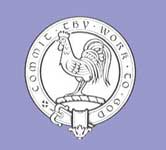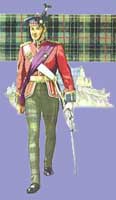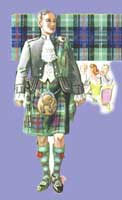Click below to find other Scottish Clans
|
|
|
| Duncan earl of Thane or Fife was riding north with one of his younger sons Shaw MacDuff, Duncan and his son were both direct descendents of King Kenneth MacAlpine who was the first recognised Scottish King. Along with the father and son rode Malcolm the fourth. They were riding North in response to a threat of a rising in the area of Moray. For security reasons Shaw was made Keeper of the strategic northern royal castle of Inverness . The clan spread and grew from that point, as they consolidated and acquired important lands round the Inverness Base, which were held for the royal government. It is a strange fact that in Gaelic the Clan Shaw are never spoken of in the singular but always as ‘The Shaws' Na S'iaich . Shaw's grand-son acquired a very important piece of land called Rothiemurchus, in the year 1236. |
|
He then had a son called Ferquhard, and when he was of age, approached Angus Mohr, Lord of Islay who had a daughter called Mora and asked to marry her. This was granted and a powerful alliance was formed with the MacDonald clan.
In the year 1291, Ferquhard's son Angus, who was the sixth chief of Mackintosh, married Eva who was daughter to Dougall Dall. He was a descendent of the famous Ghillechattan Mhor, and through this union the confederation of the historic Clan Chattan was formed.
The infamous document known as ‘The Ragmans Roll' was signed by several people named Shaw but it is generally though that they were Shaws from the Lanarkshire area in Lowland Scotland. The Peers of Scotland had been called to the town of Berwick to sign the roll as an allegiance to Edward the first of England . He had brutally murdered everyone in the town and left their bodies to rot in the streets as a lesson to any hesitant Scottish signatories.
With the coming of the second chief of the Shaws we had, Shaw MacGhillechrist Mhic Iain, who was commonly known as ‘Bucktooth'. He had a grandson called Aedh who settled at Tordarroch in the year 1468. He occupied a piece of the land which was in a very strategic position. It was directly above the fort which stood there on the banks of the river Nairn. Aedh became a power in his own right and signed Clan Chattan bands of union and manrent, in the years 1543 and again in 1609. They had become known as clan Ay.
There was a well known Farmer in Rothiemurchus, called Donald Shaw; he lived in the later part of the seventeenth century. He had a son named Lachlan , born in the year 1692; Lachlan became a school master in Abernethy, before taking a charge as a minister, firstly at the town of Kingussie , secondly Cawdor, then in Elgin . He was an amazing local Historian in the Moray area and published studies which are still of rare value today. He died in 1777.
The twenty-first Chief of Clan Shaw, John Shaw of Tordarroch was matriculated in the year of 1970, by the Lyon Court after a vacancy of four hundred years.
|
Chief: John Shaw of Tordarroch
Clan Seat: Tordarroch, Ross-shire
Plant: Unknown
Memorials : None |
|
| Back to Top |
The name Sinclair is very famous in Scotland . It always has and always will be associated with Roslyn church, and the famous Templar/Masonic link to the past.
The name Sinclair derives from Saint-Clair-sur-Elle in Normandy . The Family was established in Scotland in the year 1162 when one Henry de Saint Clair was granted lands in Hermanston near Haddington, Lothian. His descendant Sir William Saint Clair became guardian to the heir of Alexander the third. He gained the barony of Roslyn in the year of 1280. The King's heir died and so did the king himself when he fell over a cliff in the year 1286. |
|
 |
Sir Henry Sinclair of Roslyn was a supporter of King Robert the Bruce who was one of Scotland 's finest freedom fighters. Sir Henry fought at Scotland 's most famous Battle on the Twenty-fourth of June 1314 , when King Robert, quashed the mightiest army ever seen in Christendom and sent Edward the second of England fleeing for his life, and across the border to his own country. Sir Henry was rewarded in the year 1317, with a grant of lands around the Pentlands area. Sir Henry had a son who was one of King Robert the Bruce's favourites.
He was named Sir William Sinclair, and when the great Scottish patriot King died Sir William accompanied Sir James Douglas on his expedition to the holy land carrying the Kings Heart. Sir William and Sir James both died there fighting the Moors. |
William had a grandson named Henry, who through his mother Isabel became Earl of Orkney. He was an adventurer and conquered the Faroe Islands , and then discovered Greenland . It is even suggested by some that he visited sites in Canada and America but there is no definite proof of this.
The third earl of Roslyn was to become Chancellor of Scotland in the year of 1454 and he held the post for four years. In between these years he was granted the Earldom of Caithness in 1455. This was given to pacify his loss at his claim to the Lordship of Nithsdale. The two sons of the third earl split the bounty fairly, his eldest son was given Caithness and his younger son was awarded Roslyn.
The name of the clan was changing and they were now becoming known by the name Sinclair at all times. Although it is said that the Earls of Roslyn still prefer the old spelling.
Flodden was to be where the second earl was to lose his life, in the year 1513. In the year 1672, George Sinclair the sixth earl was forced to sell some of the lands because of debt, he died without an heir and this led to severe problems for the Sinclair clan.
The earldom was claimed by Sir John Campbell of Glenorchy as he owned most of the mortgages on the estate. More trouble was brewing when Sir John married the widow of George Sinclair. The two clans ended up fighting a pitched battle at Altimarlech near wick, and it was said that so many Sinclair's died that the Campbell clan could cross the stream without getting their feet wet.
The remains of Roslyn Castle and the splendid Chapel are still in Sinclair hands to this day.
|
Chief: Earl of Caithness
Clan Seat: Roslyn Castle , Midlothian , Girnigoe Castle , Wick; Brawl castle, Caithness
Plant: Furze (Whin)
Memorials: Roslyn Chapel |
 |
|
|
| Back to Top |
There are two traditional lines of descent to this famous clan. The first from Banquo, Thane of Lochaber and cousin to both King Duncan I and King MacBeth, the second from the early Counts of Brittany, also of Celtic stock, and cousins to the Merovingien Royal House of France.
It is during the reign of King David I of the Scots that the family became influential in Scotland when Walter became first Lord High Steward of Scotland, an hereditary office from which the clan took its name. Walter, sixth Lord High Steward of Scotland, Chief of the Royal Household, Collector and Minister of the crown's revenues, administrator of Justice and the King's Minister of War, commanded part of the Scottish army at the battle of Bannockburn, fought on St John's day 1314. |
|
 |
Following the battle, King Robert the Bruce knighted him. A year later, Walter married Marjorie, Lady of Scotland and Bruce's daughter. Their son, Robert II, was the first sovereign of the Royal House of Stewart in succession to his uncle, King David II
The Royal House of Stewart is the longest lasting reigning royal dynasty in Europe and the Royal House of Scotland is the oldest in Europe. Indeed, the great portrait gallery in the Palace of Holyroodhouse (commissioned by King Charles II in the 17th century) symbolises, through its 106 succeeding sovereigns, the transmission of kingship as the only unconquered kingdom in Europe. |
James I, following imprisonment in England over 18 years, re-introduced the concept of law and order following his return to power. His son, James II, galvanised Scotland into modernising her military might in parity with the rest of Europe. James III was a great promoter of the arts, architecture and particularly of music. James IV introduced the concept of a minimum wage, free education and trade unions. He also built the first official state navy in Britain. Mary, Queen of Scots, carried on the name by marrying her cousin Henry Stewart, Lord Darnley, Premier Prince of England after Elizabeth I.
James VI, their son, was the first Stewart to succeed to England as James I. His son, Charles I, who ruled England successfully for 11 years without Parliament, was toppled by Cromwell but the restoration was assured in 1660 with the crowning of Charles II in London. The crown was again lost in 1688 by his brother and successor, James VII of the Scots, II of England, when the family had to leave Britain and moved to France as exiles. Both his son, James VIII, and grandson Charles Edward, led the 1715 and 1745 risings in Scotland.
|
Joint Chiefs: Andrew Francis Stewart, 17th of Appin
John Bryson Crichton-Stuart, Lord Mount Stuart of Bute
Clan Seat:
Appin and Bute
Plant: Thistle
Memorials :
Castle Stalker |
|
| Back to Top |
| By the start of the tenth century the Norse men had settled in most of the Islands , and on huge tracts of land round the massive Scottish coastline. When they looked over across the water they named the place 'Sudrland' or in English ‘Southland'. Today we call the place Sutherland. The chief of the Sutherland clan has always been known as ‘The Black Cat' and has for a long period of history carried the ‘Black Cat' on his Arms. Some say it is a throw back to the days when the country was over-run with an abundance of wild cats. It has been suggested that the original family may have been Flemish descended from Freskin who's grandson Hugh, was granted lands in the Moray district around the year 1130, by King David the first. He then acquired estates in Sutherland and became Lord Sutherland. |
|
 |
He had a son William who was referred to as the Earl of Sutherland. Hugh's brother also named William settled in the Moray area and in fact took the name of Murray as his own, and is a direct descendent of the Dukes of Atholl.
William who was to become the third Earl of Sutherland fought along with King Robert the Bruce during his finest hour at the battle of Bannockburn . This happened on the Twenty-fourth day of June 1314, Led by Edward the second of England they claimed to be the most powerful army in Christendom but they were soundly defeated by the Scottish army and forced to flee south to England . The fourth earl was to be Kenneth, unfortunately for the Sutherland family he was killed fighting the English at the battle of Halidon Hill in the year of 1333. |
The fifth earl married King Robert the Bruce's daughter Princess Margaret, and sister of David the second. Their son was heir to the Scottish throne but alas died from plague in 1361. Robert Sutherland the sixth earl married the niece of Robert the third and was the person responsible for building the original Dunrobin castle.
The clan Sutherland could bring into the field 2,000 fighting men. In 1715 and 1745 they were among the loyal clans, and zealously supported the succession of the house of Hanover . They were totally against the Jacobite Struggle for justice and truth against the usurpers who sat on the throne of Britain . Many of whom were later enlisted in the Sutherland Fencibles, raised in 1759. William, 18th Earl who died in 1766 was the last of the Gordon Earls of Sutherland. In the year 1494, John Sutherland was to become the eighth earl but was declared un-fit to manage his own affairs by his brother-in-law Adam Gordon. After much arguing and in-fighting Gordon's wife Elizabeth was given the title.
The Earl of Sutherland was the chief of the clan, but on the accession to the earldom in 1766, of Countess Elizabeth, the infant daughter of the eighteenth earl, and afterward Duchess of Sutherland, as the Chiefship could not descend to a female, William Sutherland of Killipheder, who died in 1832, and enjoyed a small annuity from her grace, was accounted the eldest male descendant of the old earls. John Campbell Sutherland, Esq., of Fors, was afterwards considered the real chief.
|
Chief: Sutherland of that Ilk
Clan Seat: Dunrobin Castle , Sutherland
Plant: Cotton Sedge
Memorials: Dornoch Cathedral |
|
Click below to find other Scottish Clans
|
|
Back to Top
|